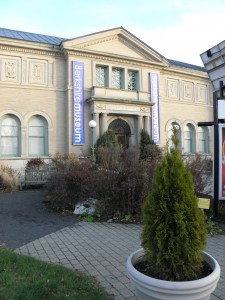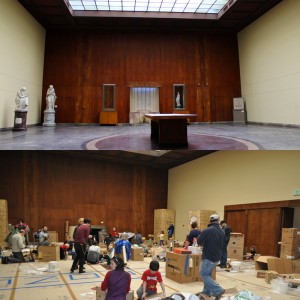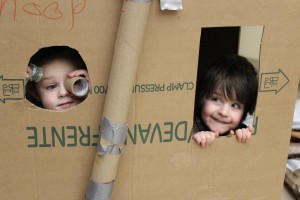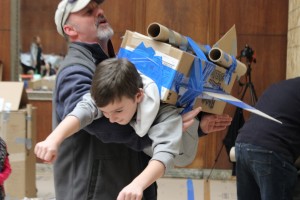Free range kids: museums at play
10 March 2014 – Kate Preissler
EDITOR’S NOTE: This post as it originally appeared on March 10 was a draft version, posted in error. The correct version appears below. We apologize to the authors and to our readers for the confusion.
Picture, for a moment, children of all ages loose in your museum; free to grab, change, move, and build with whatever their hands happen to come across. Does the image worry or excite you?
Our instincts as parents and educators, as curators and interpreters, and even just as adults, would be to take some control, to guide the children. But what if we resist that impulse? Is there anything to be gained by allowing our very youngest visitors to take total control of their own experience?
And what could be more radical for a 110 year-old museum than to completely set aside its air of erudition and cede all control of the interpretive narrative, the artistic expression, and the direction of the interactive activities to giggling toddlers and energy-filled elementary school students?

The Berkshire Museum building was built in 1903 with an architectural look that reflects the seriousness of the collection and the authority of the voice with which it was meant to educate. Photo credit: The Berkshire Museum
For two years now the Berkshire Museum has done just that with “10 Days of Play,” a February break festival of unstructured exploration, invention, creation and even destruction. First, some background: the Berkshire Museum was built in 1903 when its hometown of Pittsfield was on the rise. Founded by Zenas Crane, the museum was intended to be a serious institution of learning inspired by the Smithsonian and the Metropolitan Museum of Art. It was outfitted with an impressive and varied collection of cultural artifacts, art, and natural history specimens. Over a century later, the Berkshire Museum has been going through a process of reinventing itself in a landscape now full of cultural institutions and in a city that has seen stronger economic times. A gallery devoted to interactive exploration of innovation, an aquarium, and a theater and movie screening area are now mixed in amongst more traditional galleries filled with changing exhibits of fine arts and ancient artifacts, offering a wide range of experiences for people of all ages. The goal is now as much about adding value to the local community as it is about being a cultural destination for tourists.
As professionals at museums and historic sites we often talk about offering community value, being a community resource, or being integrated into the fabric of a community when we discuss ways to stay vibrant, solvent, and relevant in today’s world, but in my experience making those good intentions a reality is easier said than done. Which is where 10 Days of Play strikes me as an innovative experiment.
It all started when Craig, Education and Public Programming Manager, began exploring educational strategies for engaging early learners in non-traditional settings to attract more young families to the Museum. To align with the Berkshire Museum’s focus on Innovation, Inspiration, and Imagination, Craig was also looking for something that would build up and reawaken the fundamental human tendencies towards inquisitiveness and creativity. In this way he came across the concept of unstructured, child-directed play; a facet of child-development that has deep historical roots (one has to look no further than early Montessori setting or Reggio Emilia Schools). He also discovered that there were few examples of what this might look like in a museum today. Pairing this information with the knowledge that Pittsfield has few outdoor parks and natural spaces for healthy, undirected play, and that the winter in the Berkshires can mean many weeks of being shut inside, an idea for how the Berkshire Museum could truly play a crucial and valuable role to Pittsfield residents began to form.

The Crane Memorial Room before and after it has been transformed into a space of unrestricted imagination. Photo credit: The Berkshire Museum
Craig worked with Pop –Up Adventure Play, an organization that hosts and trains staff in the creation of play events, to create “10 Days of Play.” From February 14 – 23, the museum’s atrium space was put in lock-down – its stunning marble sculptures hidden under crates, the flooring protected, and emergency exit pathways mapped out along the floor. The space was then filled with cardboard, fabric, tape, recyclables, markers, and bric-a-brac culled from basements, closets, donors and every corner. The Museum provided the “stuff” and the kids provide everything else, no rules allowed.

Shyness evaporates as kids who have never previously met create and play together in the shared space. Photo credit: The Berkshire Museum
Child Directed Play (CDP) is not just a way to combat cabin fever; it also plays an important role in child-development and building strong family units. CDP is the play interaction between an adult and child in which the child is helped to direct and lead the play in any way the child wishes, unless there is harmful or destructive activity, and which has benefits for child and family development [Matthew L. Speltz, Ph.D., Seattle Learning Center Blog.

Child Directed Play lets kids and parents bond in ways that they don’t always get to. The imaginations of both begin to be unleashed in a space with no instructions. Photo credit: The Berkshire Museum
The goal of CDP and 10 Days of Play is to explore play it its many shapes and forms. The volunteers who work at 10 Days of Play are given special training in how not to intercede. They are taught to sit back and not think about whether a child is playing in the right way or wrong way but just to let them be. The unfamiliarity with truly child-led activity can often be seen in the discomfort or uncertainty of parents who, one after another, ask staff “Is this ok?” and “What should they be doing?” In fact, an added benefit of 10 Days of Play is opening up new channels and connections between parents and kids. In order for the parents to participate, they must let their guards down, literally getting down on the floor and joining in.
10 Days of Play has been a major success for the Museum on many levels. From an admissions point of view, it brings in huge crowds during a (for the Berkshires) traditionally slow time of year. This February we saw over 2,700 people come through our doors to play.
From a visitor-satisfaction point of view, it holds a joy and deep impact for families that rarely occurs in a museum setting. We have received an outpouring of positive feedback, with visitor comments ranging from “My child hasn’t sat and focused on one thing for more than 15 minutes since he could walk, we have been here for three hours,” to “This has been a great experience for our daughter, she has had trouble connecting with her peers, now she has invited the entire Crane room to her birthday party.” Another parent enthused, “It has been great to see my son disconnect from his computer and connect back with himself.”
Especially this winter, when it snowed almost every day of February break and the temps often dipped drastically down, 10 Days of Play provided a community space that was unavailable anywhere else in the city. It was a space for fun, to release energy, to spark creativity, and to forge connections between parents and children. For me, it was a rare moment of understanding the difference in visitors who are enjoying their experience and visitors who are deeply valuing their experience.
Although it may seem like mission reach, any museum that sees itself as a community resource and community asset can make use of a little play. Nontraditional learning locations like museums are free from mental connections – for kids and parents – to competition, tests, social network anxieties, and other high-pressure situations. In addition, most museums have inherently stimulating spaces – made so by the artifacts and collections on display all around. Museums provide an excellent safe, non-threatening space for people to rediscover the power of unstructured play.
An event like 10 Days of Play can bring in families that would not normally come to art and history museums. We want everyone to feel welcome and comfortable within our halls and the best way to introduce newcomers is to remove all rules and expectations. If it’s impossible to make a mistake, accidentally break traditional museum etiquette, or fail in any way, some of the most common barriers for people with no museum experience are removed. Most of the families who came to experience the playroom at the Museum took the opportunity to wander our other halls and discover what we have to offer every day of the year. When they do come in for the first time, the positive experience of play will forge a bond with the institution and the physical space that more passive visitation can never achieve. Early attachment to institutions leads to committed participants, volunteers, and donors for the future.
10 Days of Play was created because the Museum staff were exploring a way to broaden our audience and increase visitorship. In doing so, we found a real need within Pittsfield that the Museum could address while achieving our own goals. The program now embodies the spirit of museums opening doors to non-traditional audiences, pushing the boundaries of the physical space and older conventions of museums, and providing a benefit to local community members.
Has your museum or historic site seen a community need and responded to it? Do you have examples of how you have used your museum’s physical space in creative, non-traditional ways? We would love to hear more about what other museums are doing to address the question of how to become community spaces and valued community institutions while still retaining the unique sense of place that museums and historic sites have.
~ Kate Preissler is the Digital Media Marketing Manager for the Berkshire Museum, working closely with the education and interpretive staff to find ways to use new media to reach new audiences, create more opportunities for online interaction, and add informational depth and interactivity to the exhibitions.
~ Craig Langlois is the Education and Public Programming Manager for the Berkshire Museum, creating experiences at the museum for visitors of all ages.




1 comment